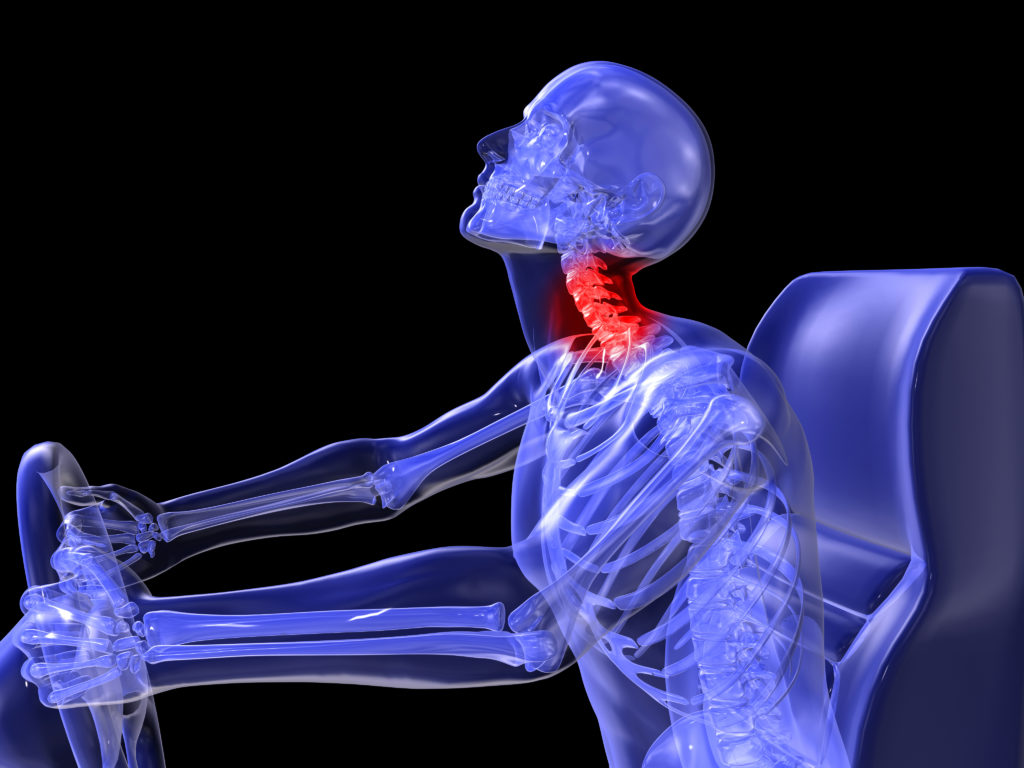
Whiplash, or whiplash associated disorder, is one of the most common diagnoses following a motor vehicle accident. Nearly everyone who has been in an accident or knows someone who has been in an accident has heard of whiplash, but what exactly is whiplash?
Definition
The term “whiplash” is not an actual medical diagnosis, but instead it describes how a neck injury is caused. Whiplash is a sudden acceleration-deceleration that causes the neck to snap forward and back, or side to side. The injuries that result from the motion of whiplash are called whiplash associated disorders, or “WAD” injuries.
Do I Have Whiplash?
The signs and symptoms of whiplash typically develop within 24 hours of an accident. In fact, people involved in motor vehicle accidents often do not experience the symptoms of whiplash associated disorders until several hours after the accident.
Symptoms of a whiplash associated disorder commonly include:
- neck pain and stiffness;
- pain with neck movements;
- headaches;
- tenderness or pain in the shoulders, upper back and arms;
- tingling and numbness in the arms;
- fatigue; and
- dizziness.
Less common symptoms include:
- blurred vision;
- ringing in the ears;
- difficulty sleeping;
- irritability;
- difficulty concentrating;
- memory problems; and
- depression.
Anyone who experiences any of these symptoms following an accident should seek medical attention.
What are the Different Types of Whiplash Associated Disorders?
We often hear people who have been injured in an accident say that they “just have whiplash”, but did you know that there are different grades of whiplash associated disorders, ranging from minor pain and stiffness all the way to a broken neck?
The table below shows how medical professionals classify whiplash associated disorders, based on the severity of the symptoms caused by the injury.
Grade
Symptoms
I
Neck stiffness, pain or tenderness only.
II
Neck stiffness, pain or tenderness AND physical symptoms such as decreased range of motion.
III
Neck stiffness, pain or tenderness AND neurological symptoms such as decreased tendon reflexes, weakness and sensory deficits.
IV
Neck stiffness, pain or tenderness AND fracture or dislocation.
How are Whiplash Associated Disorders Treated?
A person who has been injured in an accident should be assessed by a medical doctor. The doctor may diagnose that person with a WAD and may recommend physiotherapy, chiropractic treatments, massage, acupuncture, or a combination of these therapies.
A physiotherapist or chiropractor may conduct a secondary assessment of a WAD to determine or confirm the severity of the injury. Medical practitioners will also create a treatment plan with the goal of returning the injured person to their normal daily activities in a pain-free state.
Are Whiplash Associated Disorders Capped?
In Alberta, the Minor Injury Regulation imposes a cap on the amount of money that can be awarded for pain and suffering as a result of a minor injury caused by a motor vehicle accident. The 2019 cap is $5,202.00.
Under the Regulation, if a person suffers a WAD I or WAD II injury in a motor vehicle accident, and the injury does not result in a serious impairment, the injury may be capped.
A WAD I or WAD II injury may not be capped if it:
- 1) results in a substantial inability to perform employment and/or educational tasks, or normal activities of daily living;
- 2) has not resolved within 3 to 6 months of the accident; and
- 3) is not expected to substantially improve.
WAD III and WAD IV injuries are not considered minor injuries under the Regulation and are not capped, because they involve neurological issues and/or broken bones.
As with any injury suffered in a motor vehicle accident, it is important to be assessed and treated by the appropriate medical professionals. Moustarah & Company can refer you to medical professionals who specialize in the treatment and diagnosis of whiplash associated disorders. Our personal injury lawyers in Edmonton will help guide you through the claims process and determine how much your personal injury claim may be worth.
Please note: The information provided on this website does not constitute medical or legal advice and should not be construed as such. The lawyers and staff and Moustarah & Company are not trained medical professionals and do not hold themselves out to be such. If you are suffering from an injury, please contact your doctor or medical care provider.
The information provided on this website does not constitute legal advice and should not be construed as such. Moustarah & Company does not guarantee that this information is accurate or up to date. As a result, should you require legal advice, please contact a personal injury lawyer.

